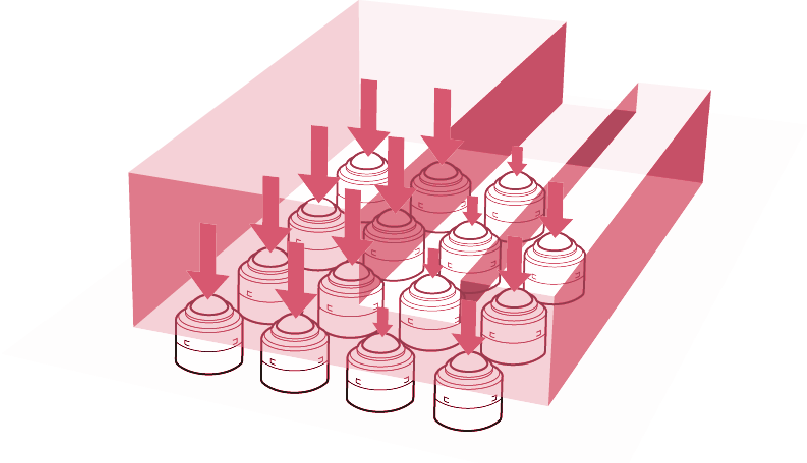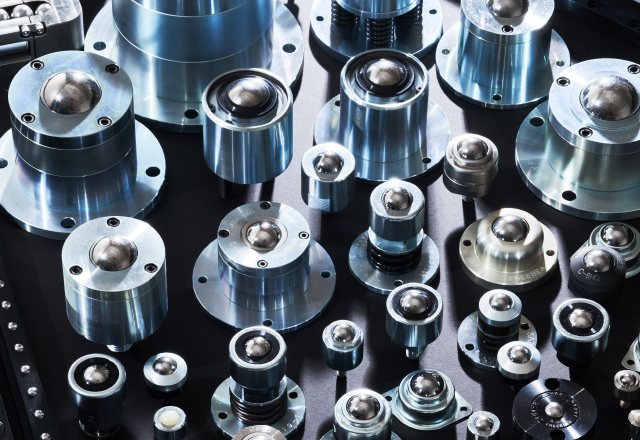How to select a freebear
What is the allowable load of freebear, Maximum load?
Allowable load
It refers to the maximum load which can be applied to a freebear
with the starting frictional resistance (μ) keeping 3/100 or less
when using a SS400-equivalent rigid body (the surface in contact
with the freebear is made of polished soft material) as the load.
Maximum load
It refers to the maximum load which can be applied to a freebear
with the starting frictional resistance (μ) keeping 3/100 or less when
the material of load uses quenched and polished steel (SK3, HRc60
or above), the moving speed is 4 km/h or less, and the moving
distance for workpiece positioning is short.

※As shown in the figure on the right, uneven load may result from the shape of the load
and other reasons. In this case, the load to be applied to each freebear must be less than
the allowable load.
Please set the mounting pitch according to the weight and size of the load.
The height of the freebear has a tolerance, and the bolster where
the freebear is mounted and the conveying surface are not
completely flat. Therefore, the load cannot be uniformly applied
to all freebears mounted, and there may be uneven load on
certain part. In such case, if the load on the freebear exceeds
the allowable load, it may have a adverse effect on the starting
frictional resistance and the service life.
For this reason,
●Cutting-machined products = Allowable load × 2/3
●Press-molded products = Allowable load × 1/2
Please determine the mounting pitch based on the load above.
However, for freebears with spring, the restriction above is void since
the freebear with uneven load is pressed down, which making more
freebears enter the contact state.

The material of the load shall also be considered.
Table I is the measured results of the “starting frictional
resistance (μ) ” to the allowable load of each freebear on our test
machine. On the test machine, the surface in contact with the ball
is made of polished quenched steel (SK3, HRc60 or above).
Table I
| C-6H | C-8H | C-12H | C-8Y | C-12K | |
|---|---|---|---|---|---|
| Test load (allowable load) | 50kg | 80kg | 200kg | 30kg | 60kg |
| Starting frictional resistance (μ) | 0.013 | 0.011 | 0.012 | 0.015 | 0.013 |
if the surface in contact with the balls is made of a different material, the starting frictional resistance measured may vary. From Table II, the starting frictional resistance (μ) of SS400 is more than twice of that of SK3; for the same SS material, the starting frictional resistance of mill scale material is more than that of polished one. Therefore, to reduce the force moving a heavy object, the bottom of the load shall be made of a hard, smooth material.
TableⅡ
C-8H(Allowable load 80kg))
| Material | |||
|---|---|---|---|
| SK3 HRc60 or above Polished contact surface | SS400 Polished contact surface | SS400 Mill scale | |
| Load 80kg | 0.92kg(μ=0.011) | 2.02kg(μ=0.025) | 2.22kg(μ=0.028) |
when the surface in contact with the ball
is made of wood, generally μ=0.09~0.1, which is about more
than 3 times of that of SS400 mill scale material. Therefore, when
conveying wood, the number of contacts shall be maximized
to disperse the load. In addition, for easier conveying, please
mount a steel plate onto the bottom of the load.
Table Ⅲ
C-8Y(Allowable load 30kg)
| Material:Wood (pine) | |
|---|---|
| Load 30kg | 2.7kg(μ=0.09) |
C-12K(Allowable load 60kg)
| Material:Wood (pine) | |
|---|---|
| Load 60kg | 5.4kg(μ=0.09) |
